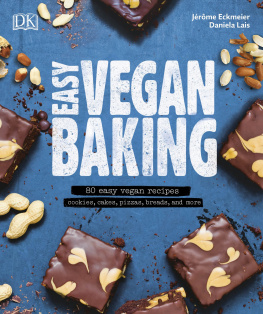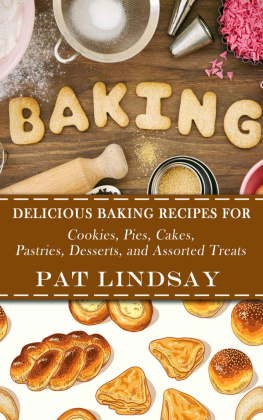The Super Easy Baking Cookbook for Teens
1000 Days Sweet and Savory Recipes for the Home Baker for Breads, Cakes, Biscuits, Pies, and More
A Baking Book
Erma Catis
Copyright 2021 Erma Catis - All Rights Reserved.
In no way is it legal to reproduce, duplicate, or transmit any part of this document by either electronic means or in printed format. Recording of this publication is strictly prohibited, and any storage of this material is not allowed unless with written permission from the publisher. All rights reserved.
The information provided herein is stated to be truthful and consistent, in that any liability, regarding inattention or otherwise, by any usage or abuse of any policies, processes, or directions contained within is the solitary and complete responsibility of the recipient reader. Under no circumstances will any legal liability or blame be held against the publisher for any reparation, damages, or monetary loss due to the information herein, either directly or indirectly.
Respective authors own all copyrights not held by the publisher.
Legal Notice:
This book is copyright protected. This is only for personal use. You cannot amend, distribute, sell, use, quote or paraphrase any part of the content within this book without the consent of the author or copyright owner. Legal action will be pursued if this is breached.
Disclaimer Notice:
Please note the information contained within this document is for educational and entertainment purposes only. Every attempt has been made to provide accurate, up-to-date and reliable, complete information. No warranties of any kind are expressed or implied. Readers acknowledge that the author is not engaging in the rendering of legal, financial, medical or professional advice.
By reading this document, the reader agrees that under no circumstances are we responsible for any losses, direct or indirect, which are incurred as a result of the use of information contained within this document, including, but not limited to, errors, omissions, or inaccuracies.
Contents
INTRODUCTION
B aking fascinates us all! Getting to see our favorite muffins, cookies or cakes turning golden brown in the oven and hearing that ring once it's done cooking is the most exciting experience that every teenager must experience. This cookbook will lend you a much-needed insight regarding the whole baking process and how as a beginner, you can get started with it. There are several everyday recipes that you can easily try at home using some basic kitchen ingredients. There are breakfast meals, pies, cookies, cakes and dinner ideas that you can enjoy baking in your kitchen. So, let's get started!
Part 1
The Basics Of Baking
B aking is a science that depends on basic knowledge of the baking process's principles. You'll be able to recreate recipes with greater ease after you grasp how each action influences the final product. To be a successful baker, you don't need a degree in chemistry or physics, but thorough awareness of the everyday science of the kitchen will give you a well-rounded understanding of baking. It's critical that you understand the scientific concepts underlying each activity that occurs when you combine flour, fat, and water to make a baked item.
Accuracy is of Essence
The same ingredients are used in almost all baked goods: flour, water, salt, fat, and leavening agents. The manner of assembling the ingredients can sometimes be the only variation between two products. The ratio of ingredients in a dish might also make a difference. Small modifications in the procedure and ratio can have a big impact on the baked good's quality. This is why it's critical to follow recipes exactly as written and accurately measure ingredients.
Measuring Ingredients
The importance of precise, exact ingredient measures cannot be overstated. It's critical to measure the ingredients precisely if you want to get the same result as the recipe author. The majority of recipes use either Imperial or metric measurements. Some recipe writers combine the two. If a recipe calls for both measurements, don't mix and match the ones you use. Make a decision and stick to it. Do not, for example, weigh the flour before measuring the rest of the ingredients in cups or ounces. This will result in measurement mistakes and have a detrimental impact on the final product.
Measuring With Perfection
Use plastic or stainless steel measuring cups to measure dry ingredients. Fluff the flour with a fork and lightly spoon it into the measuring cup. Allow the flour to mound rather than shaking the cup or packing it down. To level ingredients in the measuring cup, use a straight edge, such as a knife. Use a liquid measuring jug or cup with a pouring lip to measure liquid substances. Read the measurements at eye level by placing the cup on a flat surface. Use a measuring container that holds the exact amount of brown sugar specified in the recipe to measure it. Fill the dry measuring cup halfway with brown sugar and level it off with a straight edge. Coat the measuring cup with a little layer of cooking spray before measuring syrupy ingredients like honey, molasses, or corn syrup. This makes it easy for the component to escape.
The Importance Of Ingredient Temperature
You can use the best ingredients, measure them precisely, and mix them perfectly, but if the temperatures aren't kept under control, you risk failing. Temperature affects the characteristics of several components, particularly lipids. When producing batters and doughs, it's vital not only to temper eggs or yolks before adding them to custard but also to bring cold ingredients to room temperature. They emulsify easily when all of the ingredients are at the same temperature. As a consequence, you'll have a smooth, homogenous batter that bakes up beautifully. It's a good thumb rule to set these ingredients out on the counter unless a recipe specifically calls for them to be chilled.
Mixing Methods
The next step is to mix the components after they have been properly measured. To get the intended results, the ingredients must be blended in a certain order. The volume, look, and texture of the finished product are all influenced by the mixing technique you utilize.
Distributes the components evenly.
There are nine different mixing procedures, each with its own function. The materials are correctly blended by blending, folding, sieving, and stirring. Cutting the ingredients together also guarantees that the final dish bakes up flaky. Air is included in the batter by beating, creaming, kneading, and whipping. The baked good's ultimate texture is determined by the air pockets. Water and fats do not mix. Stirring, beating, creaming, mixing, and kneading, on the other hand, break up fats into particles, allowing them to mix with other liquids to form a homogeneous mixture. The batter should not be over-mixed. Allow batters to rest as necessary. Pay heed to the instructions in a recipe. The method used to combine the ingredients can make or break the final product.
Even Cooking
Heat will transform a thoroughly mixed batter or dough into a delectable baked treat. Make sure there's enough space between the pans in the oven for air to circulate freely. This helps to keep the oven temperature consistent and encourages even cooking. It's also crucial not to open and close the oven door during the baking process. When you open the oven's door, again and again, heat escapes, causing the temperature to drop.
Once a baked meal is removed from the oven, the baking process continues. The heated pan retains residual heat and will continue to bake as the product cools. This is why most cookie recipes warn that when you remove the cookies from the oven, they will appear undercooked. The cookies, however, will finish baking and become crisp as they cool.





